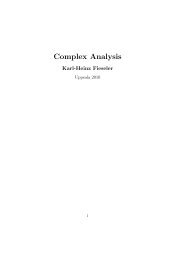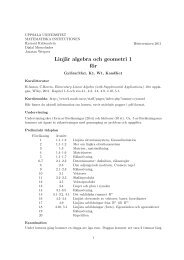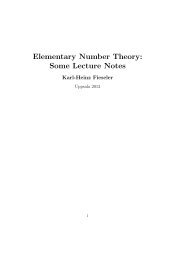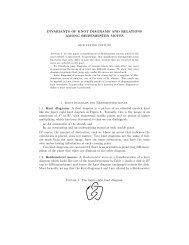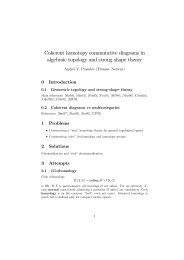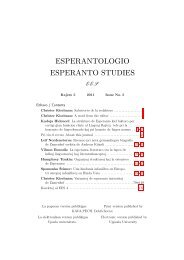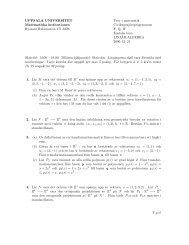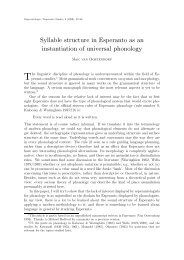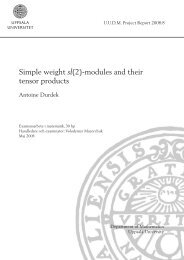Malmsten's Proof of the Integral Theorem
Malmsten's Proof of the Integral Theorem
Malmsten's Proof of the Integral Theorem
- No tags were found...
Create successful ePaper yourself
Turn your PDF publications into a flip-book with our unique Google optimized e-Paper software.
1 IntroductionDuring <strong>the</strong> eighteenth century <strong>the</strong> ma<strong>the</strong>maticians in Uppsala were mainlyastronomers, physicists or <strong>the</strong>ologians. In fact, it wasn’t until <strong>the</strong> 1820sthat Uppsala, as well as Lund, got <strong>the</strong>ir first pure ma<strong>the</strong>maticians. Maybethis was a natural ongoing process toward specialization. It could also havebeen due to <strong>the</strong> fact that <strong>the</strong> rumors <strong>of</strong> great works <strong>of</strong> Euler, d’Alembert,Lagrange and Laplace now had reached <strong>the</strong> universities <strong>of</strong> Scandinavia [3]. InUppsala, at <strong>the</strong> time, a new generation <strong>of</strong> talented ma<strong>the</strong>maticians appeared.Among <strong>the</strong> most prominent were Adolf Fredrik Svanberg (1806-1857), CarlJohan Malmsten (1814-1886) and Emanuel Gabriel Björling (1808-1872).In this report we discuss <strong>the</strong> article “Om definita integraler mellan imaginäragränsor”, which was written by C. J. Malmsten in 1865. In his work,Malmsten gives a pro<strong>of</strong> <strong>of</strong> Cauchy’s integral <strong>the</strong>orem, i.e. that <strong>the</strong> integralis independent <strong>of</strong> <strong>the</strong> path <strong>of</strong> integration (where <strong>the</strong> limits <strong>of</strong> integrationare complex numbers). The aims <strong>of</strong> this report is to try to catch <strong>the</strong> techniquesthat Malmsten made use <strong>of</strong> in his pro<strong>of</strong> and to get a glimpse <strong>of</strong> <strong>the</strong>ma<strong>the</strong>matical concepts at this time, especially those which weren’t fully investigatedand <strong>the</strong>reby gave rise to some problems for <strong>the</strong> ma<strong>the</strong>maticians.The intention is also, to some extent, to become acquainted with <strong>the</strong> ma<strong>the</strong>maticalarena in Sweden at this time.To give a background to Malmsten’s article and to see how far <strong>the</strong> development<strong>of</strong> complex analysis had reached at this time, we begin with ashort history <strong>of</strong> this field. Subsequently, a summary <strong>of</strong> Cauchy’s pro<strong>of</strong> <strong>of</strong><strong>the</strong> integral <strong>the</strong>orem will be presented, followed by a biography <strong>of</strong> Cauchy,before <strong>the</strong> exposition <strong>of</strong> Malmsten’s article. However, <strong>the</strong> report begins witha biography <strong>of</strong> Malmsten.2 Biography <strong>of</strong> MalmstenCarl Johan Malmsten (1814-1886) grew up in Uddetorp, not far from Skara.Shortly after <strong>the</strong> death <strong>of</strong> his fa<strong>the</strong>r (1827) Malmsten, who at <strong>the</strong> time wasin ’Skara skola’, obtained a favourable position as a tutor. This post made itpossible for Malmsten to study without interruptions and he was able to keep<strong>the</strong> post during his upper secondary studies as well as his university studies.In 1833 Malmsten began to study ma<strong>the</strong>matics at Uppsala university wherehe 1839 received a doctoral degree.In competition with E. G. Björling (1808-1872) Malmsten became pr<strong>of</strong>essor<strong>of</strong> ma<strong>the</strong>matics in 1841 and <strong>the</strong>reby succeeded his own teacher Jöns3




